Prioritization-Driven Congestion Control in Networks for the Internet of Medical Things: A Cross-Layer Proposal
Abstract
1. Introduction
- QCCP is a multi-objective protocol since congestion control and prioritization policies are adjusted based on various performance objectives, such as latency, packet loss, and node balance.
- QCCP supports multiple applications with different performance demands simultaneously. This is possible because QCCP abstracts from particular applications, and instead categorizes them into three classes of services: urgent (P1), important (P2), and best effort (P3).
- QCCP does not require complementary software or agents for its operation, unlike other proposals that will be detailed in Section 2. Furthermore, it does not need to modify the standard protocols of the lower layers of the node.
- QCCP proposes a packet scheduler that interacts with the node’s medium access control (MAC) sublayer to work synchronously on packet prioritization and congestion control.
- QCCP followed design principles to produce an efficient and lightweight protocol, such as: not generating control packets, minimum overhead (one bit), TCP/IP compatibility, decentralized operation, and minimum requirements of computing and power consumption.
2. Related Works
Motivation for Congestion Control in IoMT Networks
3. System Model
3.1. Network Model
3.2. Node Model
4. The Proposed Cross-Layer Scheme: QCCP Protocol
4.1. Prioritization Module
- Step 1
- CASPA obtains the weight values (W1, W2, and W3) for each buffer (Q1, Q2, y Q3), which are set by the congestion control module of the node.
- Step 2
- CASPA checks if there are packets in buffer Q1. If there is, dequeue a packet and decrement W1 by 1. Otherwise, it turns to step 4.
- Step 3
- CASPA checks if W1 ≠ 0. If so, it returns to step 2. Otherwise, it goes to the next buffer.
- Step 4
- CASPA checks if there are packets in buffer Q2. If there is, dequeue a packet and decrement W2 by 1. Otherwise, it turns to step 6.
- Step 5
- CASPA checks if W2 ≠ 0. If so, it returns to step 4. Otherwise, it goes to the next buffer.
- Step 6
- CASPA checks if there are packets in buffer Q3. If there is, dequeue a packet and decrement W3 by 1. Otherwise, it turns to step 1.
- Step 7
- CASPA checks if W3 ≠ 0. If so, it returns to step 6. Otherwise, it turns to step 1.
4.2. Congestion Control Module
4.2.1. Congestion Detection Mechanism
Congestion Degree (c)
Packet Processing Delay (Dp)
Packet Loss by Channel Access Failure (CAF)
4.2.2. Parameter Tuning
| Algorithm 1 Congestion detection function |
| Data: C, DP, CAF, and Result: Congestion level: state |
| 1 if (current_state = = I) then |
| 2 if ((TLow ≤DP < THigh) and (TLow ≤ CAF < THigh) AND (TLow ≤ C < THigh)) then |
| 3 current_state = II; congestion_resolution (state II); |
| 4 else if ((CAF ≥ THigh) OR (C ≥ THigh) OR (DP ≥ THigh)), then |
| 5 current_state = III; congestion_resolution (state III); |
| 6 end |
| 7 else if (current_state = = II) then |
| 8 if ((DP ≥ THigh) OR (CAF ≥ THigh) OR (C ≥ THigh)), then |
| 9 current_state = III; congestion_resolution (state III); |
| 10 else if ((DP < TLow) AND (CAF < TLow) AND (C < TLow)) then |
| 11 current_state = I; congestion_resolution (state I); |
| 12 end |
| 13 else if (current_state = = III) then |
| 14 if ((TL ≤ DP < THigh) AND (TLow ≤ CAF < THigh) AND (TLow ≤ C < THigh)) then |
| 15 current_state = II; congestion_resolution (state II); |
| 16 else if ((DP < TLow) AND (CAF < TLow) AND (C < TLow)) then |
| 17 current_state = I; congestion_resolution (state I); |
| 18 end |
| 19 end |
4.2.3. Congestion Notification Mechanism
4.2.4. Congestion Resolution Mechanism
Selective Packet Service
Selective BACKOFF
4.3. QCCP Protocol Parameters
5. Experimental Setup
5.1. Traffic Characteristics
5.2. Performance Metrics
5.2.1. Packet Transmission Latency (L)
5.2.2. Packet Loss Percentage (PL)
5.2.3. Throughput (TH)
6. Experimental Study
6.1. QCCP Performance Evaluation for Each Type of Traffic (First Case)
6.2. QCCP Performance Comparison with Other Transport Protocols (Second Case)
6.3. Summary of the Experimental Study
7. Statistical Analysis
7.1. Data Normality Test
7.2. Non-Parametric Tests
7.3. Statistically Performance Validation of QCCP
8. Conclusions
Author Contributions
Funding
Institutional Review Board Statement
Informed Consent Statement
Data Availability Statement
Conflicts of Interest
Abbreviations
| BE | backoff exponent |
| bps | bits per second |
| C | node congestion degree |
| CAF | channel access failure |
| CASPA | congestion-aware packet service algorithm |
| CBR | constant bit rate |
| CN | congestion notification |
| CoAP | constrained application protocol |
| CSMA-CA | carrier sense multiple access with collision avoidance |
| CWND | congestion window |
| DP | packet processing delay |
| ECG | electrocardiogram |
| EWMA | exponential weighted moving average |
| H0 | null hypothesis |
| IoMT | internet of medical things |
| IoT | internet of things |
| L | packet transmission latency |
| MAC | medium access control |
| macMaxBE | minimum value of BE |
| macMaxCSMABackoff | maximum number of backoffs |
| macMinBE | minimum value of BE |
| maxBackoff | macMaxCSMABackoff |
| maxBE | macMaxBE |
| Md | medians |
| minBE | macMinBE |
| MQTT | message queuing telemetry transport |
| ms | millisecond |
| NS2 | Network Simulator 2 |
| PL | Packet loss percentage |
| pps | packets per second |
| QCCP | priority-based cross-layer congestion control protocol |
| Qn | Buffer n |
| QoS | quality of service |
| rin | scheduler input rate |
| rloc | local traffic |
| rMAC | input rate to MAC sublayer |
| rout | node output rate |
| rprog | scheduler output rate |
| rtr | transit traffic |
| TCP | transport control protocol |
| TH | Throughput |
| THigh | high threshold |
| Tlow | low threshold |
| UDP | user datagram protocol |
| Wn | weight of buffer n |
References
- Atzori, L.; Lera, A.; Morabito, G. Internet of Things: A Survey. Comput. Netw. 2010, 54, 2787–2805. [Google Scholar] [CrossRef]
- Holler, J.; Tsiatsis, V.; Mulligan, C.; Avesand, S.; Karnouskos, S.; Boyle, D. From Machine-to-Machine to the Internet of Things: Introduction to a New Age of Intelligence, 1st ed.; Academic Press, Inc.: Cambridge, MA, USA, 2014; ISBN 0-12-407684-X. [Google Scholar]
- Ang, K.L.M.; Seng, J.K.P. Application Specific Internet of Things (ASIoTs): Taxonomy, Applications, Use Case and Future Directions. IEEE Access 2019, 7, 56577–56590. [Google Scholar] [CrossRef]
- Islam, S.M.R.; Kwak, D.; Kabir, M.H.; Hossain, M.; Kwak, K. The Internet of Things for Health Care: A Comprehensive Survey. IEEE Access 2015, 3, 678–708. [Google Scholar] [CrossRef]
- Usak, M.; Kubiatko, M.; Shabbir, M.S.; Viktorovna Dudnik, O.; Jermsittiparsert, K.; Rajabion, L. Health Care Service Delivery Based on the Internet of Things: A Systematic and Comprehensive Study. Int. J. Commun. Syst. 2020, 33, e4179. [Google Scholar] [CrossRef]
- Durán-Vega, L.A.; Santana-Mancilla, P.C.; Buenrostro-Mariscal, R.; Contreras-Castillo, J.; Anido-Rifón, L.E.; García-Ruiz, M.A.; Montesinos-López, O.A.; Estrada-González, F. An IoT System for Remote Health Monitoring in Elderly Adults through a Wearable Device and Mobile Application. Geriatrics 2019, 4, 34. [Google Scholar] [CrossRef]
- Santana-Mancilla, P.C.; Anido-Rifón, L.E.; Contreras-Castillo, J.; Buenrostro-Mariscal, R. Heuristic Evaluation of an IoMT System for Remote Health Monitoring in Senior Care. IJERPH 2020, 17, 1586. [Google Scholar] [CrossRef] [PubMed]
- Castrejón Mejía, O.E.; Santana-Mancilla, P.C.; Fajardo-Flores, S.B. Design and Development of a Wearable System for the Analysis of Respiratory Patterns for Health Monitoring in Seniors. Av. IHC 2021, 1, 91–93. [Google Scholar] [CrossRef]
- Besher, K.M.; Beitelspacher, S.; Nieto-Hipolito, J.I.; Ali, M.Z. Sensor Initiated Healthcare Packet Priority in Congested IoT Networks. IEEE Sens. J. 2020, 21, 11704–11711. [Google Scholar] [CrossRef]
- Buenrostro, M.R.; Ivan, N.H.J.; Antonio, G.I.J.; Maria, C.L.; Mabel, V.B.; Dios, S.L.J. de Análisis de Factores Que Afectan El QoS Que Ofrecen Las WSN Aplicado a Entornos de Salud. Rev. Difucion Cient. 2013, 7, 54–62. [Google Scholar]
- Buenrostro-Mariscal, R.; Cosio-Leon, M.; Nieto-Hipolito, J.-I.; Guerrero-Ibanez, J.-A.; Vazquez-Briseno, M.; Sanchez-Lopez, J.-D. WSN-HaDaS: A Cross-Layer Handoff Management Protocol for Wireless Sensor Networks, a Practical Approach to Mobility. IEICE Trans. Commun. 2015, E98.B, 1333–1344. [Google Scholar] [CrossRef]
- Leyva-Mayorga, I.; Pla, V.; Martinez-Bauset, J.; Rivero-Angeles, M.E. A Hybrid Method for the QoS Analysis and Parameter Optimization in Time-Critical Random Access Wireless Sensor Networks. J. Netw. Comput. Appl. 2017, 83, 190–203. [Google Scholar] [CrossRef]
- Rao, Y.; Deng, C.; Zhao, G.; Qiao, Y.; Fu, L.; Shao, X.; Wang, R. Self-Adaptive Implicit Contention Window Adjustment Mechanism for QoS Optimization in Wireless Sensor Networks. J. Netw. Comput. Appl. 2018, 109, 36–52. [Google Scholar] [CrossRef]
- Zhang, W.; Wei, X.; Han, G.; Tan, X. An Energy-Efficient Ring Cross-Layer Optimization Algorithm for Wireless Sensor Networks. IEEE Access 2018, 6, 16588–16598. [Google Scholar] [CrossRef]
- Besher, K.M.; Nieto-Hipolito, J.I.; Buenrostro-Mariscal, R.; Ali, M.Z. Spectrum Based Power Management for Congested IoT Networks. Sensors 2021, 21, 2681. [Google Scholar] [CrossRef] [PubMed]
- Aceto, G.; Persico, V.; Pescapé, A. The Role of Information and Communication Technologies in Healthcare: Taxonomies, Perspectives, and Challenges. J. Netw. Comput. Appl. 2018, 107, 125–154. [Google Scholar] [CrossRef]
- Rezaee, A.A.; Yaghmaee, M.H.; Rahmani, A.M.; Mohajerzadeh, A.H. HOCA: Healthcare Aware Optimized Congestion Avoidance and Control Protocol for Wireless Sensor Networks. J. Netw. Comput. Appl. 2014, 37, 216–228. [Google Scholar] [CrossRef]
- Buenrostro-Mariscal, R.; Santana-Mancilla, P.C.; Montesinos-López, O.A.; Nieto Hipólito, J.I.; Anido-Rifón, L.E. A Review of Deep Learning Applications for the Next Generation of Cognitive Networks. Appl. Sci. 2022, 12, 6262. [Google Scholar] [CrossRef]
- Malhotra, J. A Survey on Cross Layer Routing Protocols for Manet. In Proceedings of the 2014 International Conference on Advances in Engineering & Technology Research (ICAETR-2014), Unnao, India, August 2014; pp. 1–3. [Google Scholar]
- Al-Kashoash, H.A.A.; Hafeez, M.; Kemp, A.H. Congestion Control for 6LoWPAN Networks: A Game Theoretic Framework. IEEE Internet Things J. 2017, 4, 760–771. [Google Scholar] [CrossRef]
- Edirisinghe, R.; Zaslavsky, A. Cross-Layer Contextual Interactions in Wireless Networks. IEEE Commun. Surv. Tutor. 2013; early access online. [Google Scholar] [CrossRef]
- Fu, B.; Xiao, Y.; Deng, H.; Zeng, H. A Survey of Cross-Layer Designs in Wireless Networks. IEEE Commun. Surv. Tutor. 2014, 16, 110–126. [Google Scholar] [CrossRef]
- Sridevi, S.; Usha, M. Taxonomy of Transport Protocols for Wireless Sensor Networks. In Proceedings of the Recent Trends in Information Technology (ICRTIT), Chennai, India, 3–5 June 2011; pp. 467–472. [Google Scholar]
- Jan, S.R.U.; Jan, M.A.; Khan, R.; Ullah, H.; Alam, M.; Usman, M. An Energy-Efficient and Congestion Control Data-Driven Approach for Cluster-Based Sensor Network. Mob. Netw. Appl. 2018, 24, 1295–1305. [Google Scholar] [CrossRef]
- Liu, Y.; Wang, K.; Guo, H.; Lu, Q.; Sun, Y. Social-Aware Computing Based Congestion Control in Delay Tolerant Networks. Mob. Netw. Appl. 2017, 22, 174–185. [Google Scholar] [CrossRef]
- Dong, M.; Meng, T.; Zarchy, D.; Arslan, E.; Gilad, Y.; Godfrey, P.B.; Schapira, M. PCC Vivace: Online-Learning Congestion Control. In Proceedings of the 15th USENIX Conference on Networked Systems Design and Implementation, Renton, WA, USA, 9–11 April 2018; pp. 343–356. [Google Scholar]
- Ma, Y.; Tian, H.; Liao, X.; Zhang, J.; Wang, W.; Chen, K.; Jin, X. Multi-Objective Congestion Control. In Proceedings of the Seventeenth European Conference on Computer Systems, New York, NY, USA, 28 March 2022; Association for Computing Machinery: New York, NY, USA, 2022; pp. 218–235. [Google Scholar]
- Gu, Y.; Grossman, R. UDT: UDP-based data transfer for high-speed wide area networks. Comput. Netw. 2007, 51, 1777–1799. [Google Scholar] [CrossRef]
- Narayan, A.; Cangialosi, F.; Raghavan, D.; Goyal, P.; Narayana, S.; Mittal, R.; Alizadeh, M.; Balakrishnan, H. Restructuring Endpoint Congestion Control. In Proceedings of the Conference of the ACM Special Interest Group on Data Communication (SIGCOMM’18), Budapest, Hungary, 20–25 August 2018; pp. 30–43. [Google Scholar] [CrossRef]
- Wang, C.; Li, B.; Sohraby, K.; Daneshmand, M.; Hu, Y. Upstream Congestion Control in Wireless Sensor Networks through Cross-Layer Optimization. IEEE J. Sel. Areas Commun. 2007, 25, 786–795. [Google Scholar] [CrossRef]
- Lubna, T.; Mahmud, I.; Cho, Y.-Z. D-LIA: Dynamic Congestion Control Algorithm for MPTCP. ICT Express 2020, 6, 263–268. [Google Scholar] [CrossRef]
- Raiciu, C.; Handley, M.J.; Wischik, D. Coupled Congestion Control for Multipath Transport Protocols; Internet Engineering Task Force: London, UK, 2011. [Google Scholar]
- Mudassir, M.U.; Baig, M.I. MFVL HCCA: A Modified Fast-Vegas-LIA Hybrid Congestion Control Algorithm for MPTCP Traffic Flows in Multihomed Smart Gas IoT Networks. Electronics 2021, 10, 711. [Google Scholar] [CrossRef]
- Jin, C.; Wei, D.X.; Low, S.H. FAST TCP: Motivation, Architecture, Algorithms, Performance. In Proceedings of the IEEE INFOCOM 2004, Hong Kong, China, 7–11 March 2004; Volume 4, pp. 2490–2501. [Google Scholar]
- Jain, N.; Srivastava, D.N. TCP I-Vegas in Mobile-IP Network. Int. J. Adv. Comput. Sci. Appl. (IJACSA) 2014, 5, 142–147. [Google Scholar] [CrossRef]
- LAN/MAN Standard Committee. IEEE Std 802.15.4-2006 (Revision of IEEE Std 802.15.4-2003); IEEE Standard for Information Technology–Local and Metropolitan Area Networks–Specific Requirements–Part 15.4: Wireless Medium Access Control (MAC) and Physical Layer (PHY) Specifications for Low Rate Wireless Personal Area Networks (WPANs). IEEE: Minneapolis, MN, USA, 2006; pp. 1–320. [CrossRef]
- Arnon, S.; Bhastekar, D.; Kedar, D.; Tauber, A. A Comparative Study of Wireless Communication Network Configurations for Medical Applications. IEEE Wirel. Commun. 2003, 10, 56–61. [Google Scholar] [CrossRef]
- Francini, A.; Chiussi, F.M.; Clancy, R.T.; Drucker, K.D.; Idirene, N.E. Enhanced Weighted Round Robin Schedulers for Accurate Bandwidth Distribution in Packet Networks. Comput. Netw. 2001, 37, 561–578. [Google Scholar] [CrossRef]
- Wu, H.; Zhang, Q.; Zhu, W. Design Study for Multimedia Transport Protocol in Heterogeneous Networks. In Proceedings of the Communications, ICC ’03, Anchorage, AK, USA, 11–15 May 2003; Volume 1, pp. 567–571. [Google Scholar]
- Roth, D.; Montavont, J.; Noël, T. Overhearing for Congestion Avoidance in Wireless Sensor Networks. In Proceedings of the Ad-hoc, Mobile, and Wireless Networks; Frey, H., Li, X., Ruehrup, S., Eds.; Springer: Berlin/Heidelberg, Germany, 2011; pp. 131–144. [Google Scholar]
- Anastasi, G.; Conti, M.; Di Francesco, M. A Comprehensive Analysis of the MAC Unreliability Problem in IEEE 802.15.4 Wireless Sensor Networks. IEEE Trans. Ind. Inform. 2011, 7, 52–65. [Google Scholar] [CrossRef]
- Rohm, D.; Goyal, M.; Xie, W.; Polepalli, B.; Hosseini, H.; Divjak, A.; Bashir, Y. Dynamic Reconfiguration in Beaconless IEEE 802.15.4 Networks under Varying Traffic Loads. In Proceedings of the IEEE Global Telecommunications Conference, GLOBECOM 2009, Honolulu, HI, USA, 30 November–4 December 2009; pp. 1–8. [Google Scholar]
- Egbogah, E.E.; Fapojuwo, A.O. A Survey of System Architecture Requirements for Health Care-Based Wireless Sensor Networks. Sensors 2011, 11, 4875–4898. [Google Scholar] [CrossRef]
- Ikram, M.; Seppanen, S.; Sliz, R.; Hamalainen, M.; Pomalaza-Rez, C. Implementation Issues for Wireless Medical Devices. In Proceedings of the International Symposium on Medical Information and Communication Technology (ISMICT-07), Oulu, Finland, 11–13 December 2007; pp. 200–206. [Google Scholar]
- Calixto-Sanchez, E.P.; Cosio-Leon, M.; Buenrostro-Mariscal, R.; Nieto-Hipolito, J.I.; Martinez-Vargas, A. Is Cognitive Radio an Opportunity to Improve the Performance of the IEEE 802.15.4 in Mobile e-Health Scenarios? IEEE Lat. Am. Trans. 2019, 17, 1220–1226. [Google Scholar] [CrossRef]
- Postel, J. Transmission Control Protocol. STD 7, RFC 793, September 1981. Available online: https://www.rfc-editor.org/info/rfc793 (accessed on 2 December 2022). [CrossRef]
- Floyd, S.; Gurtov, A.; Henderson, T. The NewReno Modification to TCP’s Fast Recovery Algorithm. RFC 3782: April 2004. Available online: https://datatracker.ietf.org/doc/rfc3782/ (accessed on 2 December 2022).
- Brakmo, L.S.; O’Malley, S.W.; Peterson, L.L. TCP Vegas: New Techniques for Congestion Detection and Avoidance. In Proceedings of the Conference on Communications Architectures, Protocols and Applications, London, UK, 31 August–2 September 1994; ACM: New York, NY, USA, 1994; Volume 24, pp. 24–35. [Google Scholar]
- Stanford-Clark, A.; Linh Truong, H. MQTT For Sensor Networks (MQTT-SN) Protocol Specification; International Business Machines Corporation (IBM): Armonk, NY, USA, 2013. [Google Scholar]
- Chevrollier, N.; Golmie, N.T. On the Use of Wireless Network Technologies in Healthcare Environments. In Proceedings of the 5th Workshop on Applications and Services in Wireless Networks, Paris, France, 5–10 June 2005. [Google Scholar]
- Henrion, S.; Mailhes, C.; Castanié, F. Transmitting Critical Biomedical Signals over Unreliable Connectionless Channels with Good QoS Using Advanced Signal Processing. WSEAS Trans. Commun. 2004, 3, 694–699. [Google Scholar]
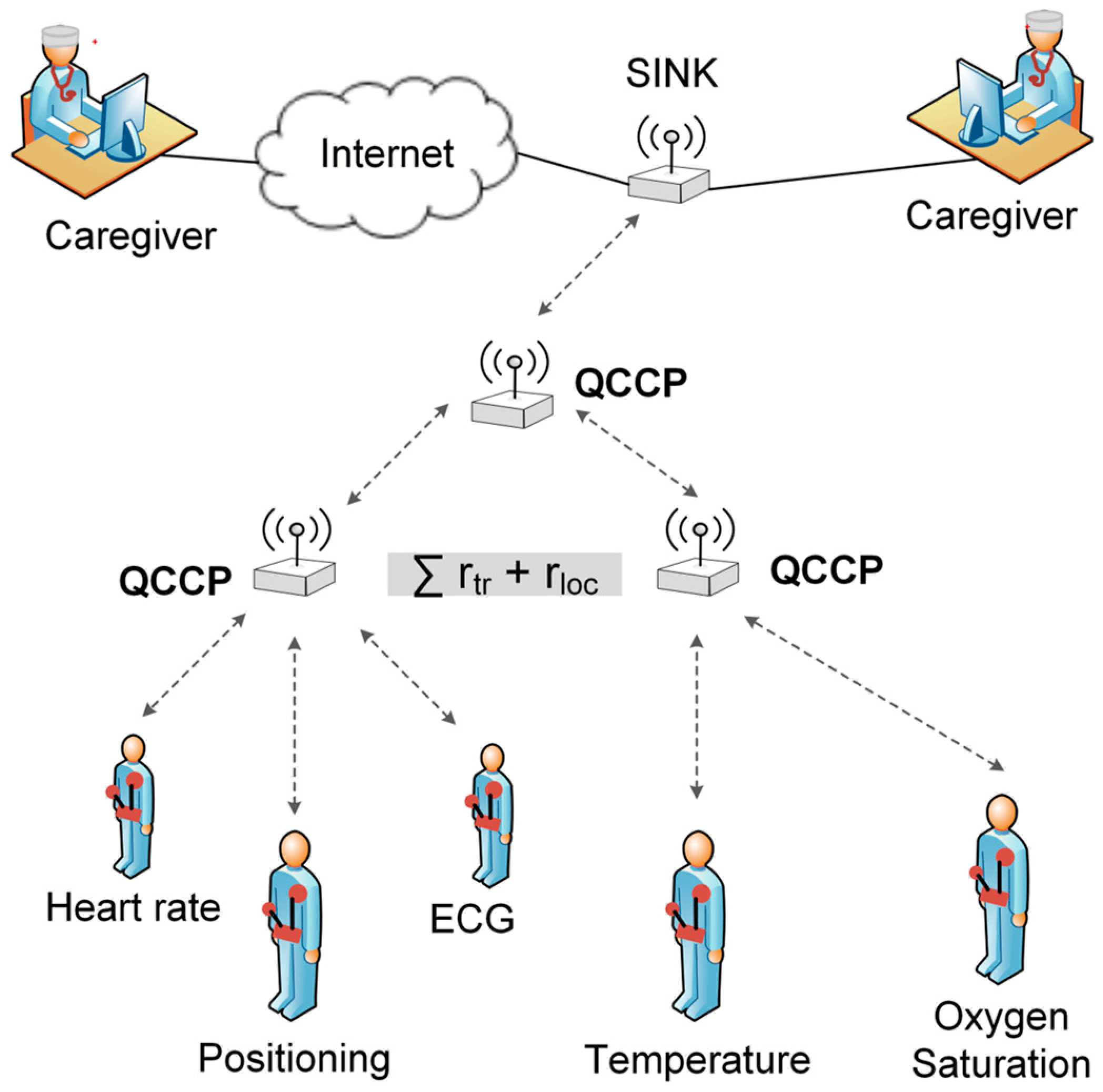
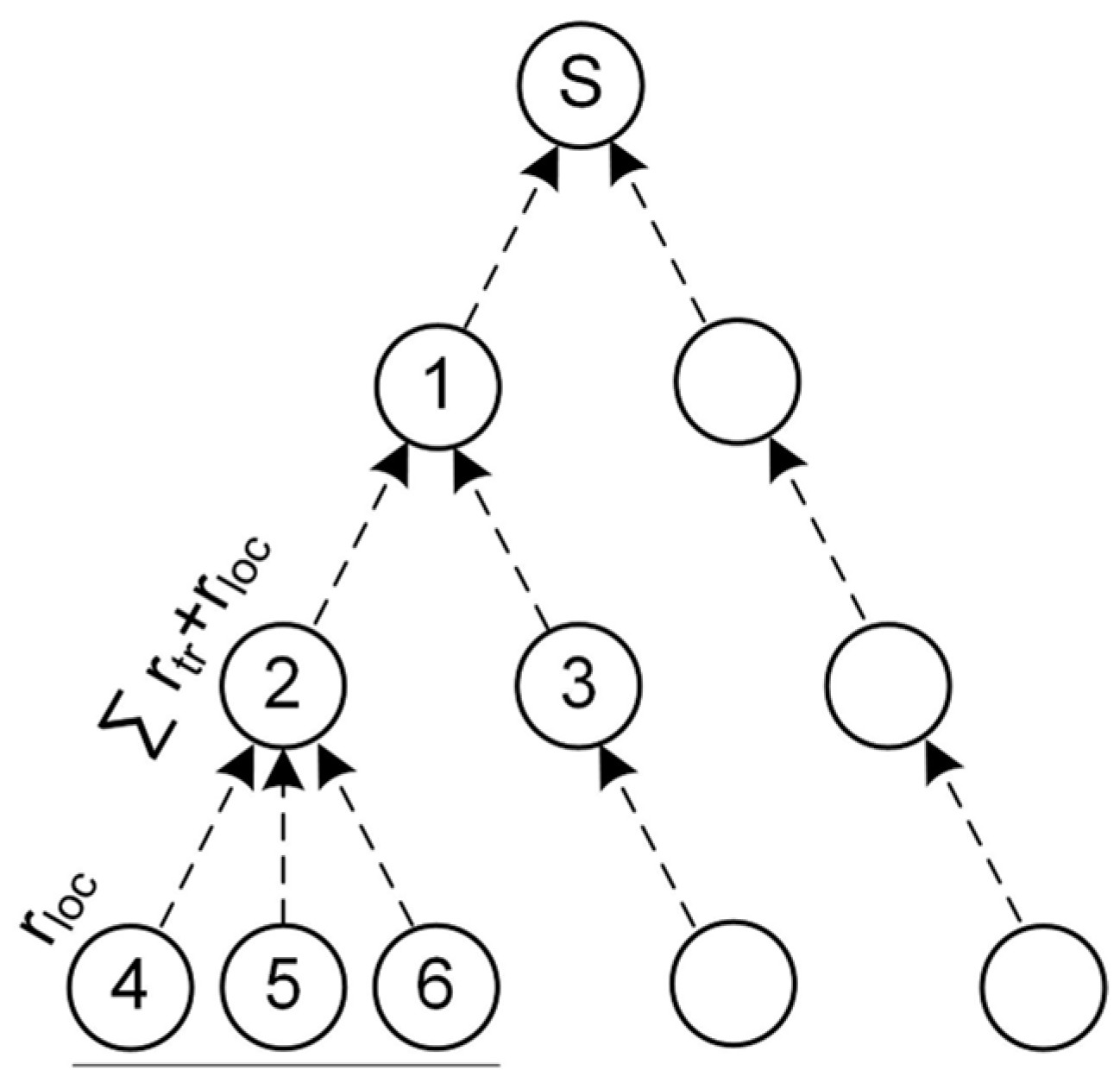



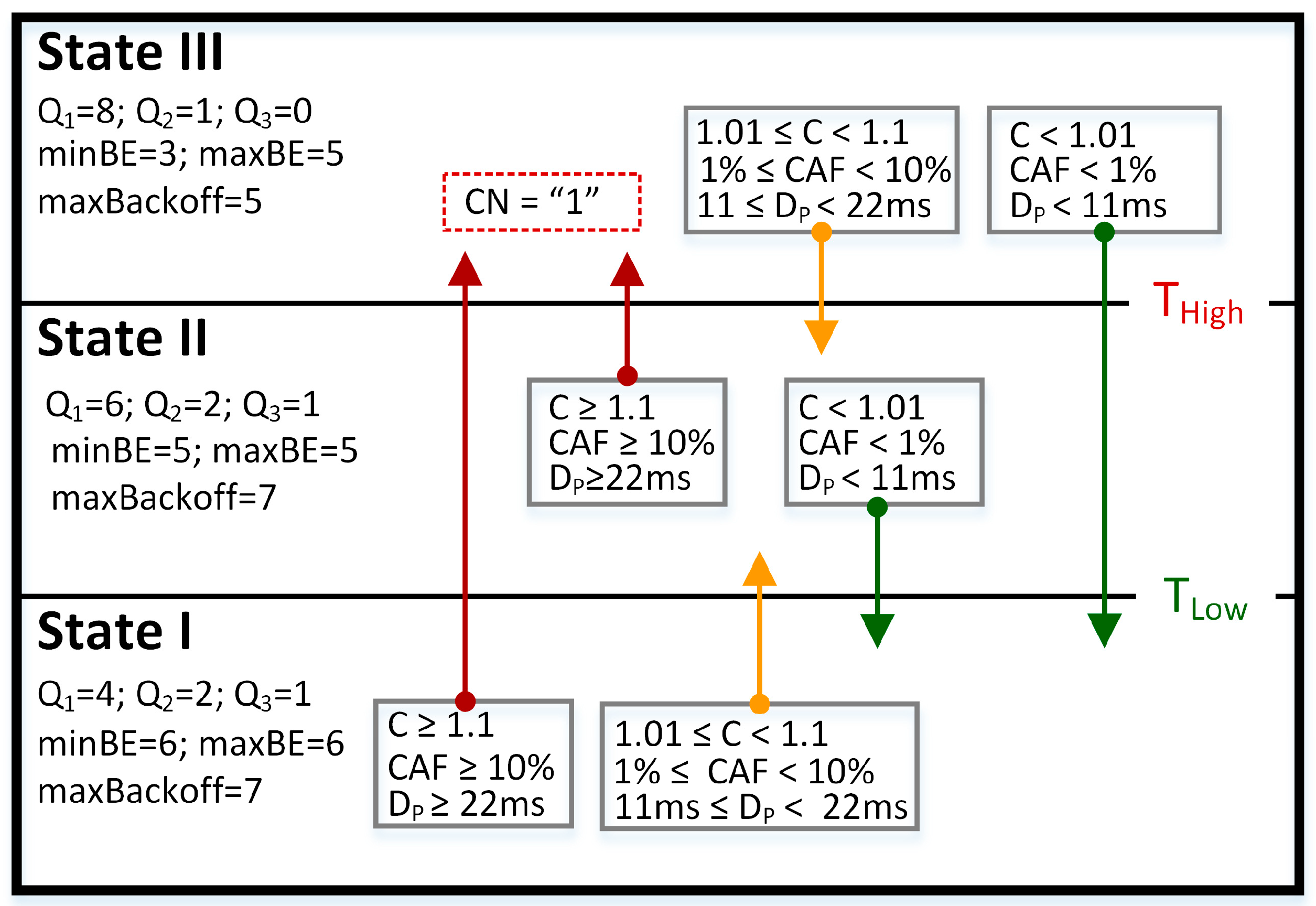

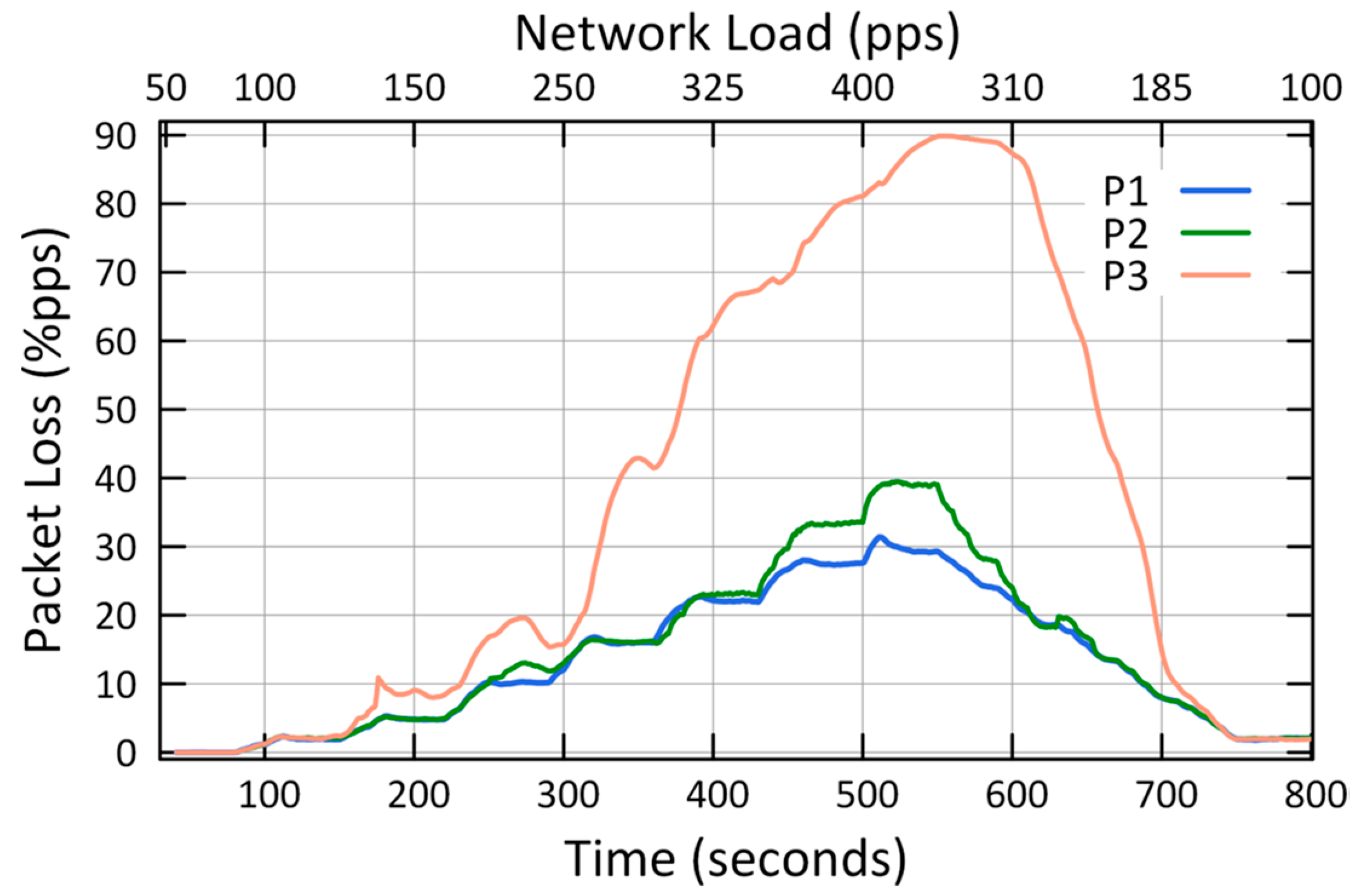


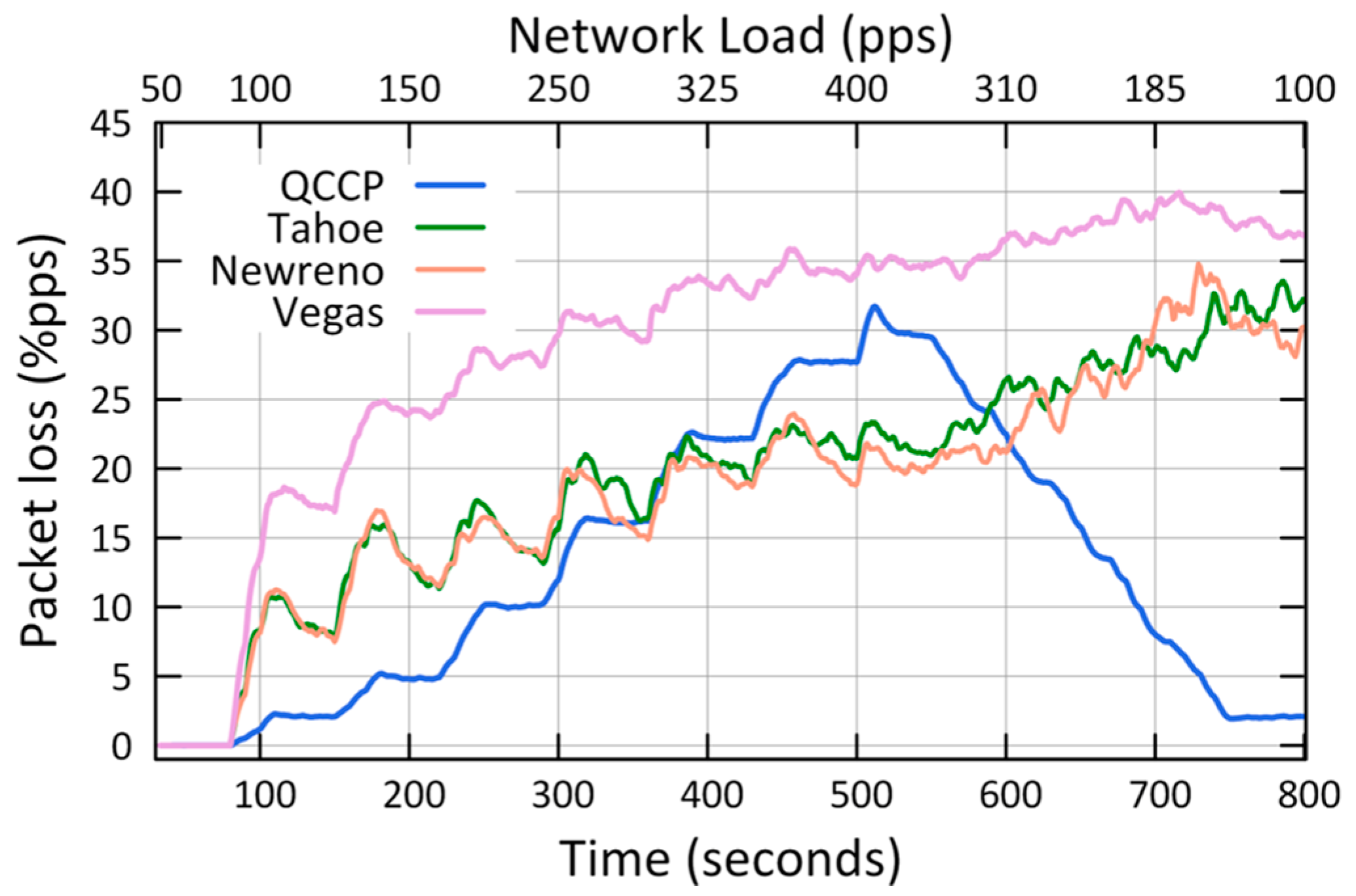

| State I | State II | State III |
|---|---|---|
| DP < 11 ms | 11 ms ≤ DP < 22 ms | DP ≥ 22 ms |
| CAF < 1% | 1% ≤ CAF < 10% | CAF ≥ 10% |
| C < 1.01 | 1.01 ≤ C < 1.1 | C ≥ 1.1 |
| Congestion | Q1 Buffer | Q2 Buffer | Q3 Buffer |
|---|---|---|---|
| State I | Weight = w × 1.0 | Weight = w × 0.5 | Weight = w × 0.25 |
| State II | Weight = w × 1.5 | Weight = w × 0.5 | Weight = w × 0.25 |
| State III | Weight = w × 2.0 | Weight = w × 0.25 | Weight = w × 0 |
| Congestion | minBE | maxBE | maxBackoff |
|---|---|---|---|
| State I | 6 | 6 | 7 |
| State II | 5 | 5 | 7 |
| State III | 3 | 5 | 5 |
| Parameter | Values |
|---|---|
| Application agent | Constant Bit Rate (CBR) |
| Routing agent | Static routing |
| Transport protocols | QCCP, TCP (Tahoe, NewReno, Vegas) |
| MAC-PHY protocol | IEEE 802.15.4 (Non-Beacon mode) |
| Node’s size buffer | seven packets for each queue |
| Packet size | 80 Bytes [10] |
| Wireless channel rate | 250 kbps (one channel at 2.4 GHz) |
| Performance Metric | State I 190 pps | State II 285 pps | State III 400 pps |
|---|---|---|---|
| L (seconds) | |||
| Tahoe | 0.0736 | 0.0686 | 0.0588 |
| Newreno | 0.0771 | 0.0745 | 0.0655 |
| Vegas | 0.0275 | 0.0282 | 0.0286 |
| QCCP | 0.0162 | 0.0161 | 0.0149 |
| PL(% pps) | |||
| Tahoe | 13.7433 | 16.4479 | 20.7432 |
| Newreno | 13.1389 | 14.8692 | 18.8666 |
| Vegas | 25.3355 | 29.2678 | 34.0296 |
| QCCP | 6.3170 | 16.2162 | 27.6790 |
| TH (pps) | |||
| Tahoe | 29.5580 | 29.2245 | 28.6615 |
| Newreno | 29.3666 | 29.3547 | 29.1040 |
| Vegas | 32.8587 | 31.5950 | 31.1818 |
| QCCP | 52.1215 | 81.9238 | 87.3884 |
| Metric | Compared Protocols | Statistic W | p-Value | |
|---|---|---|---|---|
| QCCP (Md) | Newreno (Md) | |||
| TH | 86 | 28.50 | 8.68 | <0.001 |
| L | 0.0147 | 0.0535 | −8.68 | <0.001 |
| PL | 27.70 | 18.58 | 7.13 | <0.001 |
| QCCP (Md) | Tahoe (Md) | |||
| TH | 86 | 30 | 8.68 | <0.001 |
| L | 0.0147 | 0.0430 | −8.68 | <0.001 |
| PL | 27.70 | 19.70 | 6.41 | <0.001 |
| QCCP (Md) | Vegas (Md) | |||
| TH | 86 | 31.50 | 8.68 | <0.001 |
| L | 0.0147 | 0.0274 | −8.68 | <0.001 |
| PL | 27.70 | 33.80 | −7.60 | <0.001 |
| Metric | Mean Value | Limit Value | T-Value (GL = 99) | p-Value (α = 0.05) | Target Value |
|---|---|---|---|---|---|
| TH | 86.47 | 85.460 | 103.62 | <0.001 | 23.44 |
| PL | 27.62 | 27.85 | −30.55 | <0.001 | 32 |
| L | 0.01483 | 0.0150 | −59.4 | <0.001 | 0.0213 |
Disclaimer/Publisher’s Note: The statements, opinions and data contained in all publications are solely those of the individual author(s) and contributor(s) and not of MDPI and/or the editor(s). MDPI and/or the editor(s) disclaim responsibility for any injury to people or property resulting from any ideas, methods, instructions or products referred to in the content. |
© 2023 by the authors. Licensee MDPI, Basel, Switzerland. This article is an open access article distributed under the terms and conditions of the Creative Commons Attribution (CC BY) license (https://creativecommons.org/licenses/by/4.0/).
Share and Cite
Buenrostro-Mariscal, R.; Santana-Mancilla, P.C.; Montesinos-López, O.A.; Vazquez-Briseno, M.; Nieto-Hipolito, J.I. Prioritization-Driven Congestion Control in Networks for the Internet of Medical Things: A Cross-Layer Proposal. Sensors 2023, 23, 923. https://doi.org/10.3390/s23020923
Buenrostro-Mariscal R, Santana-Mancilla PC, Montesinos-López OA, Vazquez-Briseno M, Nieto-Hipolito JI. Prioritization-Driven Congestion Control in Networks for the Internet of Medical Things: A Cross-Layer Proposal. Sensors. 2023; 23(2):923. https://doi.org/10.3390/s23020923
Chicago/Turabian StyleBuenrostro-Mariscal, Raymundo, Pedro C. Santana-Mancilla, Osval Antonio Montesinos-López, Mabel Vazquez-Briseno, and Juan Ivan Nieto-Hipolito. 2023. "Prioritization-Driven Congestion Control in Networks for the Internet of Medical Things: A Cross-Layer Proposal" Sensors 23, no. 2: 923. https://doi.org/10.3390/s23020923
APA StyleBuenrostro-Mariscal, R., Santana-Mancilla, P. C., Montesinos-López, O. A., Vazquez-Briseno, M., & Nieto-Hipolito, J. I. (2023). Prioritization-Driven Congestion Control in Networks for the Internet of Medical Things: A Cross-Layer Proposal. Sensors, 23(2), 923. https://doi.org/10.3390/s23020923









